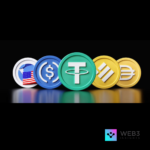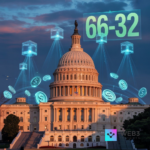Stablecoins aren’t the flashiest part of crypto, but they’re the most essential. With over $250 billion in total value, these digital dollars are the lifeblood of blockchain finance. Whether you’re trading Bitcoin, minting NFTs, or lending on DeFi platforms, chances are you’re using a stablecoin to do it.
So when the U.S. government rolls out a bill to regulate them, the ripple effects aren’t small, they’re seismic. From Tether and USDC to the upcoming Ripple stablecoin, this legislation could redraw the crypto landscape in real time.
Let’s explore what this bill is all about, why it matters, and how it might reshape everything from innovation to adoption in the stablecoin world.
The Stablecoins Market Is Bigger Than You Think
According to recent reporting from Barron’s, stablecoins underpin a massive portion of the $3.3 trillion crypto market. Traders prefer stablecoins over fiat when buying or selling crypto tokens. Why? Speed, liquidity, and global access.
Tether (USDT), issued by Tether Holdings, is the OG of stablecoins. It’s everywhere. Circle’s USDC, launched in partnership with Coinbase, is rregulated, and clean. And now Ripple wants in, preparing to launch its own stablecoin that could challenge the incumbents.
Stablecoins aren’t just used for speculation anymore. Issuers see them as potential replacements for outdated cross-border payment systems. They’re betting on a future where stablecoins lower fees, improve remittance flows, and even disrupt the traditional banking rails.
What’s Actually in the U.S. Stablecoin Bill?
It starts by putting stablecoin issuers under federal supervision. That means if you’re issuing a stablecoin, you’ll need to follow clear rules. Regular audits, solid capital reserves, and real, verifiable backing. No vague promises just proof that your digital dollar is actually worth a dollar.
To help keep things in check, the bill also proposes a new committee: the Stablecoin Certification Review Committee. This group would review stablecoins to see if any of them could pose a big risk to the financial system. They’d look at how the coin works, who runs it, and whether it’s truly safe.
One of the most debated parts of the bill is about Big Tech. Companies like Meta or Amazon wouldn’t be allowed to issue their own stablecoins without special approval. Lawmakers worry that tech giants could move too fast and get too powerful in the money game.
Finally, the bill wants to protect your privacy. It says companies can’t use or sell your stablecoin transaction data without your permission. That’s a big deal, especially in an online world where data often gets used without us knowing.
What Stablecoins Could Mean for Crypto
1. Clearer Regulations, Bigger Capital Inflows
When rules are clear, big investors feel safer. If this bill gives stablecoins a solid legal base, more money could pour into crypto, from banks, hedge funds, and other big players.
2. Bridging Crypto and Traditional Finance
Regulated stablecoins might show up in places like PayPal, Venmo, or even traditional banks. You could send money across the world or pay someone instantly, all without needing a regular bank account.
3. Shifting Perceptions of Crypto
The bill could help shift the narrative around crypto. Right now, a lot of people still see crypto as risky or shady. This bill could help change that. If stablecoins become trusted and well-regulated, they could bring more users and more real-world use.
Institutions Pioneering Stablecoins Adoption
Major players in traditional finance are already paving the way for stablecoin adoption, and they’re not waiting for regulation to catch up.
Mastercard, for instance, has launched a pilot program enabling users to settle transactions in USDC. It’s a signal that one of the world’s largest payment networks sees regulated stablecoins as a future standard for cross-border payments.
Visa is also deep in the space. It has partnered with Circle to test stablecoin settlement and integrate crypto into its broader network. By doing so, it’s betting on blockchain’s potential to reduce friction in the payment process.
PayPal has gone even further, launching its own stablecoin, PYUSD aimed at making crypto more usable for the average consumer. With backing from Paxos and regulatory support, it’s one of the first major tech-finance hybrids to enter the stablecoin race.
These moves aren’t just experiments, they’re early adoption signals from companies that have the infrastructure to scale.
If legislation aligns with their innovation goals, we could see these integrations move from pilot programs to everyday payment options across the globe.
Conclusion
The U.S. stablecoin bill is more than legislation, it’s a turning point. As stablecoins become integral to global finance, clarity from Washington could determine which players thrive and which ones fade.
If the bill gets it right, the next wave of stablecoins won’t just be crypto tools. They’ll be financial infrastructure, open, programmable, and global.
Whether you’re holding USDC, trading with Tether, or waiting for the Ripple stablecoin to hit the market, one thing’s clear: regulation is coming. The question now is whether it will protect users and foster growth, or put the brakes on a revolution that’s already well underway.








